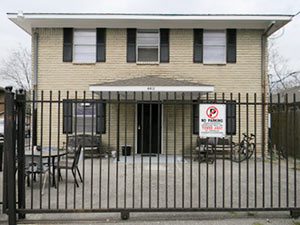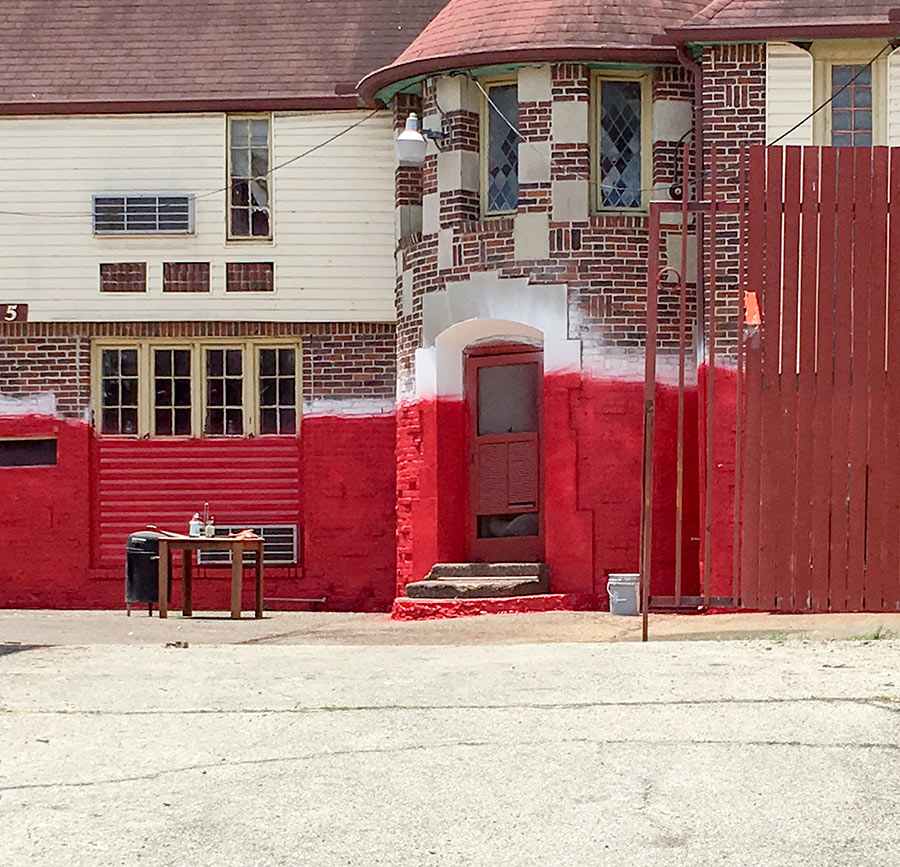THE PROPOSED NEW RULES FOR ROOMING HOUSES  A new PowerPoint presentation put together by the city’s Administrative and Regulatory Affairs department details the requirements that the city is proposing putting in place for rooming houses — places where 3 or more unrelated people live together. Among the standards that could be laid down for the unregulated buildings: requiring them to apply for annual permits, instituting building code inspections, and mandating the facilities have framed beds, posted and practiced fire evacuation plans, accessible fire extinguishers, working smoke alarms, carbon monoxide detectors, and first aid supplies. Mayor Turner announced last May that he was planning on stepping up regulations for the shared homes after a fire at one such facility on Griggs Rd. just east of OST killed 2 boarders in March. The city is presenting the proposed changes at a meeting in the Near Northside next Wednesday. New regulations for houses serving elderly, disabled, and formerly-incarcerated people are also up for consideration. [Administrative and Regulatory Affairs] Photo of rooming house at 4411 New Orleans St.: Roominghouses.net
A new PowerPoint presentation put together by the city’s Administrative and Regulatory Affairs department details the requirements that the city is proposing putting in place for rooming houses — places where 3 or more unrelated people live together. Among the standards that could be laid down for the unregulated buildings: requiring them to apply for annual permits, instituting building code inspections, and mandating the facilities have framed beds, posted and practiced fire evacuation plans, accessible fire extinguishers, working smoke alarms, carbon monoxide detectors, and first aid supplies. Mayor Turner announced last May that he was planning on stepping up regulations for the shared homes after a fire at one such facility on Griggs Rd. just east of OST killed 2 boarders in March. The city is presenting the proposed changes at a meeting in the Near Northside next Wednesday. New regulations for houses serving elderly, disabled, and formerly-incarcerated people are also up for consideration. [Administrative and Regulatory Affairs] Photo of rooming house at 4411 New Orleans St.: Roominghouses.net





The cost of having two roommates might just skyrocket.
This stuff reads like it was written for places that have multiple individual rooms that they rent by the room, but the way it’s worded, it also applies to a typical Montrose landlord renting out an unfurnished bungalow to 3-4 unrelated recent college graduates. That was my first post-college housing.
“Framed beds”? “Practiced fire evacuation plan”? How do you even enforce this stuff?
.
The part about fire extinguishers and smoke alarms I think is already part of the code, or state law, or something.
.
Annual permit? Nonsense!
@GoogleMaster:
I think the point is to make regs that will drive the rental market out of neighborhoods. Stopping unrelated people from living together is a legal no-no, but this could achieve the same effect through more defensible means.
Having smoke detectors, etc., isn’t objectionable, and neither are occasional inspections. But the framed bed req and the fire evacuation plan req suggest this isn’t just about safety.
Bryan and College Station did this a few years back capping rentals at 4 tenants just as all the new SF construction coming online was 5bdr. The work around that most landlords went with was to have only the maximum (4) on the lease, then let the tenants work it out.
Per the previous comment, it’s basically unenforceable. It’s on par with long-term guest clause in a standard rental agreements – I’m not aware of any landlords actually enforcing that except in special situations where you need cause to evict.
Occupancy and fire exits is key here. The whole thing came about because there was a “rooming house†operating behind a Storefront in a strip mall. It worked as an Residential occupancy but was in a building designed for Business occupancies. It didn’t have sufficient exits among other things.
.
Incidentally, a focus on occupancies could also help address unlicensed after hours night clubs – since many of those are effectively Assembly occupancies but in buildings designed for Business occupancies- as well as unregistered HAZMAT storage if they exceed the quantities of hazardous materials allowed in Business occupancies.
.
How to get inspectors in there? Easy for the rooming houses and nightclubs: follow HPD around. If there’s a crime scene investigation on the site, get building inspectors out right after the crime investigation is done but before taking down all the tape. For Hazmats it would have to be complaint based unfortunately. Or maybe tied to air quality monitoring.
.
Another thing to note: Harris County already has registration requirements for residential board and care facilities: including rooming houses, halfway houses, assisted living facilities, etc. the City and County could enter an inter local agreement to combine their registrations for these to use the same forms and regulations. It would make it a lot simpler for everyone.
All of these new regulations seem to have an ulterior motive to drive out places that rent to more people than what is “safe”. What “safe” means is a whole other question.
.
I can agree with GoogleMaster’s opinion that an annual permit requirement is a bunch of hooey. At the least, it is a way to raise a few dollars for the City to squander. At the most, it will allow an inspection to occur before issuing the permit. But, an inspection is only as good as it is on the day of the inspection.
.
Common sense would indicate that renters would know and maintain their own fire emergency routes. If the tradeoff is lower rent to live in a tinderbox, let the people (and market) decide what their level of risk is. Personally, I like a low level so I’ll pay more – and I’ll make a fuss to my landlord if there are threats to emergency exits.
“If the tradeoff is lower rent to live in a tinderbox, let the people (and market) decide what their level of risk is.”
.
Ah, the ol’ “invisible hand of the market” waves itself. Let me translate into real-capitalist speak: “If you’re too poor to choose, you get to live with the slum lords, and the rest of us don’t care.”
.
Whatever the actual impact or even intent behind this is, be it driving high-density rentals out of residential neighborhoods as J thinks, a money grab like you say, or really about safety, this at least provides some legal recourse for the all-but-homeless to have at least a vaguely safer place to stay. Mind, if the cost of compliance really is significant, then we may see a spike in homelessness as some of the worst flophouses are forced to close. But IMO, if they’re really this bad, allowing them to operate and to claim the residents aren’t functionally homeless when they’re living in dangerous conditions is just disingenuous.
Chris C: excellent comment!!!! I would point out that safety isn’t just about fire code. There’s also sanitation, Structural soundness, and crime on the site that can have bad affect on tenants. And as you said, those who can’t afford better are stuck.
.
In general Houston does a lousy job enforcing codes in low rent housing. Whether it’s rooming houses or apartments, they fall into the same trap. Everything is complaint based and usually it’s neighbors in well off areas that complain the loudest. Apartments and rooming houses in Montrose that are fine but just need a coat of paint and some landscaping wind up getting red tagged repeatedly, while big complexes in Westwood, Gulfton, and Greenspoint are ignored despite numerous structural, sanitary, and fire code violations.
““If you’re too poor to choose, you get to live with the slum lords, and the rest of us don’t care.â€
.
let me translate that from liberal speak “If you’re too poor to afford housing that we demand to be acceptable, you can sleep on the street”
.
Chris: No doubt that these rules result in HIGHER PRICED HOUSING. Just like a rule that said “Sorry, 400 SF is just too small. Not fair to the poor. We demand all apartments be at least 700SF.
.
You may find it worth it. Others may not. You may want a baseline that’s higher than other people would like to or can pay. But it’s not up to you (or me, or anyone) to decide what’s right for someone else.
.
What happens to the people that could afford something shitty, but can’t afford something after new requirements come in? Or are you so clueless that you think these regulations will have NO effect on price? They’ll simply be costs that are absorbed by the evil property owners?
.
Excuse me if I trust the free market (where people VOLUNTARILY trade goods and services to the benefit of both parties) over the heavy handed force of the government.
Chris C.
.
Excellent comment! If they can’t afford to live by the standards that you deem acceptable then they will have to live on the streets, I guess?
pretty lazy response to suggest that the only 2 options are poor people living in unsafe housing or on the streets. i understand that sometimes regulations go too far, but getting rid of regulations entirely just doesnt make sense because there are tons of situations where the invisible hand of the market actually provides incentive for people to do the wrong thing. one extreme example is the case of monopolies. another is pollution. in practice, there is plenty of evidence that economics is driving some landlords to continually operate unsafe, under maintained properties and they are continuing to make enough profit to not want to change on their own. who else is going to step in to ensure public safety if economics isn’t adequate to the task?
.
instead of continuing to advance this unrealistic fantasy of a libertarian utopia, why not be a part of the argument about how best to balance regulation so that it does its job of protecting the public good in cases where economics is inadequate while limiting the unintended consequences it can cause if not applied optimally. if you have a suggestion of another way rules can be created that will accomplish the goal with a lower impact on rent then i’d like to hear it, but to just blow it off and say that the market will handle it is just lazy and not backed up by historical evidence.
Lazyass: Well said. I have to wonder if some people might be happier in Brazil, or India, or maybe Hong Kong. In Brazil, housing law allows for Favelas. In India, slums. In Hong Kong, coffin-apartments: half the size of jail cells in US prisons.
.
The point is it’s all fine and we’ll to talk about libertarian utopias: if someone wants to live in an unsafe or unsanitary Home, let them. It’s quite a different matter to put that into practice.